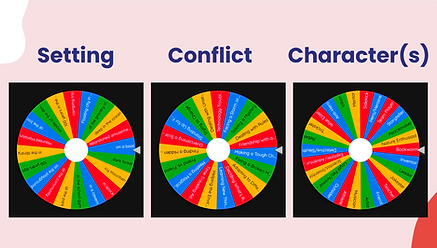Shadow Theatre
Overview
Grade Level: 4th
Big Idea: Time / Light & Shadow / Motion
Rationale and Context: This lesson aims to introduce fourth-grade students to concepts of time through story-based play and experimentation of light, shadow, color, and motion. The focus is on creative exploration, the manipulation of everyday objects, and imaginative storytelling through shadow puppets
Key Concepts
-
Time is a measure of change.
-
Time changes meaning, perspective, and experiences.
-
Artists and designers experiment with forms, structures, materials, concepts, media, and art-making approaches.
-
Light and shadow are important in conveying mood.
Essential Questions
-
How can light/shadow be used to communicate with others?
-
How does knowing the contexts histories, and traditions of art forms help us create works of art and design?
-
How do artists and designers learn from trial and error?
Integration
Digital Learning
Global Collaborator
Students use appropriate technologies, including assistive technologies, to broaden their perspectives and enrich their learning by collaborating with others and working effectively in teams locally and globally
Language Arts
Students will engage in writing and storytelling.
Learning Objectives
Learners will be able to work collaboratively to plan a cohesive 3-act story structure.
Learners will be able to perform a shadow puppet play using light, shadow, and puppets.
Virginia Art Standards
4.10 - The student will use contemporary media, which may include digital media, to create works of art individually or collaboratively.
4.5 - The student will demonstrate skills needed to work collaboratively in an art community. a) Provide and receive constructive feedback.
Materials
Teacher: Projector, Computer, Camera, Fishing Line, Hot glue gun, Utility knife
Students: Light sources, String, Masking tape, Scissors, Physical shapes/patterns, Paper, Iridescent cellophane, Clear bottles with water, cardstock, shadow boxes, Popsicle sticks, Small hole punch, Pencils, Erasers, hinges, Sketchbooks, Aluminum Wire, Pipe Cleaners

Process
Day 1:
Introduce students to concepts of light and shadow by learning the vocabulary terms: Light Source, Opaque, Translucent, and Transparent.*
Engage in a discussion about Anila Agha's work and her approach to manipulating light to evoke diverse moods in her installations. Discussion Question: How does Anila Agha achieve different moods with light in her installations?
Following this, students move into an exploration phase where each table is provided with a light box and various materials. They delve into hands-on experimentation, investigating the interplay of light, shadow, color, and motion, all the while documenting their findings on the back side of their planning sheet.
Returning to the carpet, students share their discoveries and insights garnered from the experimentation phase. As a foundation for student's narrative planning, show students a short video about story structure from Pixar.
Adapting the Visual Thinking Routine - Beginning, Middle, End—make the demonstration for using the 3-act story structure planning guide interactive with the class. This activity offers an opportunity for students to model effective planning techniques. Next, organize students into their respective groups.
Studio time for students to engage in a comprehensive planning session to brainstorm and outline their shadow puppetry plays.
The session concludes with a quick clean-up and line-up, ensuring a smooth transition to the next activity.
* Pre-Assessment:
Find out by a show of hands how many students have heard of the terms before. I used the animation feature in Google slides to make this process interactive with the whole class.


Day 2:
The day kicks off with a carpet session where students are shown a captivating shadow puppet video, serving as a catalyst for revisiting ideas explored in the previous class.
Following this, students engage in a focused session to finalize their play plans, ensuring coherence and clarity in their narratives.*
A brief demonstration on constructing hinged puppets is provided, equipping students with the necessary skills for their puppet creation endeavors.
Subsequently, students are allocated studio time to commence work on crafting their puppets and scenic elements.
As the session draws to a close, students engage in a clean-up and line-up routine, preparing for the next phase of their project.

*Notes:
When my students needed support in facilitating their own productive group conversations, I used 'Discussion Sentence Starters'
For those that were having difficulty coming up with ideas for their story, I made Spin Wheels with different ideas about setting, conflict, and characters for them to use.

Day 3:
The session commences with a carpet session focused on shadow scenery design, where students discuss techniques for creating immersive backgrounds to enhance storytelling.
Following this, students are allotted time to immerse themselves in creating the scenic elements for their plays, focusing on setting the appropriate mood and atmosphere.*
Students then return to the carpet for a brief exploration of Kara Walker's shadow artwork, drawing parallels to their own creations and fostering discussions on artistic interpretation.
The session proceeds with crafting characters for their puppet plays, ensuring attention to detail and character development.
Finally, students engage in a clean-up and line-up routine, concluding the session on an organized note.
*Notes:
Questions I asked students think about:
-
What is the setting of your story?
-
What features can be represented - on the side, the side? On the ground? In the sky?
-
Where can you add articulated features to make your character move or walk?



Day 4:
The day begins with a carpet session consisting of a review of the previous class, followed by the viewing of selected segments from an artist explaining his work and process with shadow puppets.
Expectations for the upcoming presentations are outlined during this time.*
Students then embark on a studio session where they complete their presentation guides, with the teacher providing guidance and support to each group.
A TAG peer review activity allows groups to provide constructive feedback to one another, fostering collaboration and improvement.
The remainder of the session is dedicated to studio time where groups record their presentations as they become ready.
The session concludes with a clean-up and line-up routine, marking the end of the shadow theatre journey.
*Formative Assessment:
Individual/Group consultations about the collaborative performance requirements
